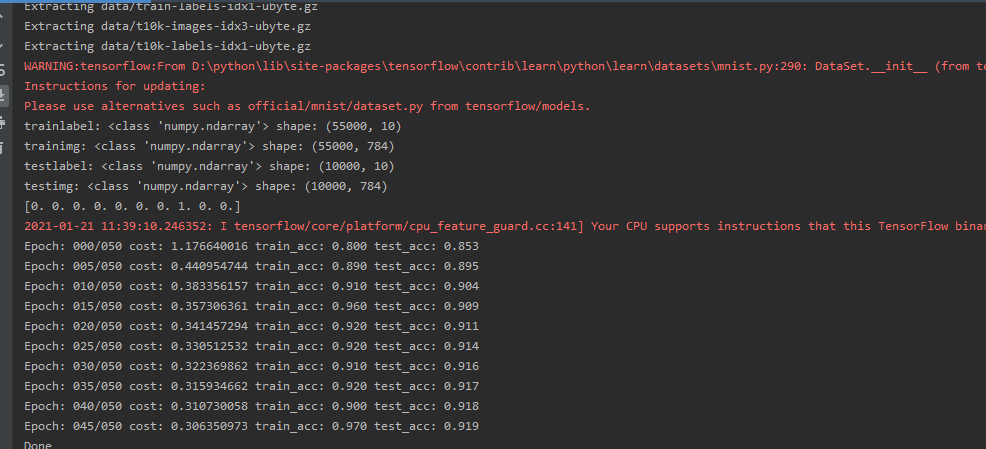今天通过观看老师分享的TensorFlow教学视频,完成了逻辑回归模型的创建,内容比较复杂代码也比较陌生,理解起来非常费力。
具体代码如下:
import tensorflow as tf
import numpy as np
import matplotlib.pyplot as plt
from tensorflow.examples.tutorials.mnist import input_data
mnist = input_data.read_data_sets('data/',one_hot=True)
trainimg = mnist.train.images
trainlabel = mnist.train.labels
testimg = mnist.test.images
testlabel = mnist.test.labels
print("trainlabel:",type(trainlabel),"shape:",trainlabel.shape)
print("trainimg:",type(trainimg),"shape:",trainimg.shape)
print("testlabel:",type(testlabel),"shape:",testlabel.shape)
print("testimg:",type(testimg),"shape:",testimg.shape)
print(trainlabel[0])
x = tf.placeholder("float",[None,784])
y = tf.placeholder("float",[None,10])
W = tf.Variable(tf.zeros([784,10]))
b = tf.Variable(tf.zeros([10]))
#计算模型
actv = tf.nn.softmax(tf.matmul(x,W) + b)
#损失
cost = tf.reduce_mean(-tf.reduce_sum(y*tf.log(actv),reduction_indices=1))
#学习参数
learning_rate = 0.01
#梯度下降优化器
optm = tf.train.GradientDescentOptimizer(learning_rate).minimize(cost)
#对比预测值的索引和真实值的索引
pred = tf.equal(tf.argmax(actv,1),tf.argmax(y,1))
#把true或false转换成1或0求均值作为精度
accr = tf.reduce_mean(tf.cast(pred,"float"))
init = tf.global_variables_initializer()
training_epochs = 50
batch_size = 100
display_step = 5
sess = tf.Session()
sess.run(init)
for epoch in range(training_epochs):
avg_cost = 0
num_batch = int(mnist.train.num_examples/batch_size)
for i in range(num_batch):
batch_xs,batch_ys = mnist.train.next_batch(batch_size)
sess.run(optm,feed_dict={x:batch_xs,y:batch_ys})
feeds = {x:batch_xs,y:batch_ys}
avg_cost += sess.run(cost,feed_dict=feeds)/num_batch
if epoch % display_step ==0:
feed_train = {x:batch_xs,y:batch_ys}
feed_test = {x:mnist.test.images,y:mnist.test.labels}
train_acc = sess.run(accr,feed_dict=feed_train)
test_acc = sess.run(accr,feed_dict=feed_test)
print("Epoch: %03d/%03d cost: %.9f train_acc: %.3f test_acc: %.3f"
% (epoch,training_epochs,avg_cost,train_acc,test_acc))
print("Done")
运行截图:
